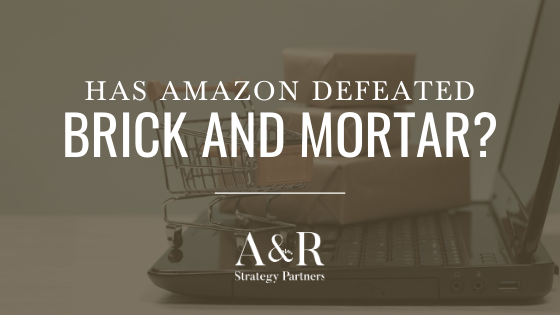CNBC posted a copy of the first job description, written and advertised by Jeff Bezos, in the early days of Amazon. The founder and CEO of Amazon was looking for developers to “help pioneer commerce on the Internet.”1 Now, whether you’re a frequent Amazon shopper or a critic of the e-commerce giant, I think that consensus can be found in the fact that Amazon did just that.
Initially started as an online marketplace for books in 1994, Amazon’s rising success has disrupted the brick and mortar landscape and has changed the story surrounding how consumers shop. While there’s no doubt that Amazon has impacted consumers and companies with its online success, has it completely killed brick and mortar?
Many companies are remaining strong and they’re finding ways to keep their brick and mortar presence relevant and prosperous.
A journey that has been referred to as “clicks to bricks,” is an example of how brands that solely live online, are finding influence and benefit in brick and mortar. Warby Parker and Casper are models of this transition from online-only to retail shops.
Casper, an online mattress shop, has opened stores such as The Dreamery, in New York City, where you can pay to take a 45-minute nap in a pod that is furnished with a Casper mattress and bedding. While mattresses aren’t actually sold there, it gives potential consumers an opportunity to test a mattress and it gives the company a way to project its brand image.
So why is there such a contrast between the stores that see the value in brick and mortar (and are succeeding) and established companies such as Toys “R” Us and Sears who have been forced to close their doors? Did they fail to keep up with what consumers are demanding from their in-store experience?
Nordstrom provides a relevant example of how a retail store is working to create an experience for their loyal customer base. Nordstrom has launched a 320,000 square foot, seven-floor store, right by Central Park in NYC. It boasts seven restaurants and bars, 100,000 pairs of shoes across three floors, 100 different beauty brands, and more. The Nordstrom store also lets customers eat while they shop. The Shoe Bar allows customers to order drinks to sip on while trying on shoes, and for customers who are not interested in sitting down for a meal in-store, they can place an order with a sales associate, and have their food delivered right to them, wherever they might be shopping.
So, what can we learn from Nordstrom? While other well-known department stores are struggling in the New York market, Nordstrom’s 4-years-in-the-making project is going all in, adapting to consumers’ needs, tailoring their approach based on their customers’ changing expectations, and focusing on creating a unique shopping experience that aligns with their buyers’ journeys.
While I don’t believe that Amazon and e-commerce have killed brick and mortar, they have altered the way that consumers look at convenience, experience, customer service, and efficiency.
Do you have an online brand or brick and mortar presence? How are you ensuring that your customer remains engaged? Here are 5 keys to making brick and mortar work for your brand.
Know your customer
If you haven’t compiled adequate and ongoing research about your customers’ behaviors, habits, needs, and preferences, you are defeating your company all on your own. Who are your customers? How would you define their shopping experience? What is going to get them in the doors? What will get them to return? Understanding your customer will allow you to continue to deliver the products and services that make the most sense, and ensure that you add value to your customers’ shopping experience so that they continue coming to you, rather than clicking away at home.
Put the shopper first
Now it’s time to convert that research into action! Based on your information, it’s up to you to create a positive, customer-centered shopping experience that meets the needs and surpasses the expectations of every shopper that walks through your doors. Focus on engaging your consumers, adding value to their purchasing decisions, and providing a seamless way of interacting with your sales team and your products. Immerse yourself in how your customer thinks, feels, and acts, and put their perspective first to ensure that you are reaching them at their most comfortable level.
Prioritize the experience
It’s all about the experience! With online shopping knocking at your door, you have to enhance your in-store experience, just like Nordstrom. This doesn’t mean that you need a massive flagship store to make your experience memorable to the customer. Think about offering your buyers ways to interact with your products on a more meaningful level and explore in-store services that engage all of their senses. Shopping online doesn’t allow for the tactile shopping experience, so capitalize on that! It’s all about making shopping in-store a pleasure.
Increase product transparency
More and more significance is being placed on how products are made, what ingredients they contain, and how they affect health and the environment. Reading packages, examining ingredient labels, and understanding company values have all found a place in consumers’ shopping experiences. So why not make it easy for them? Rethink your displays, shelves, ads, and sales training so that product transparency is at the forefront of your in-store strategy. Your customers will appreciate it and it will allow them to feel comfortable with their purchasing decision.
Get creative
The strategies behind brick and mortar plans are getting more creative than ever! From pop-up retail stores to out-of-the-box approaches to the customer experience, the online competition is making it imperative to up your game! Whether it’s a new method of utilizing technology to enhance the customer experience or an interactive in-store design to get customers excited, now is the time to break the norm and think beyond what’s already been done. Your goal is not to do what everyone else is doing, but to stand out by doing something that no one has done.
The rise of Amazon and the popularity of shopping from the comfort of your home doesn’t mean that brick and mortar is a thing of the past. It’s all about the adaptation of your strategy and the agility of your brand. When your strategy is focused on brand differentiation and the customer experience, you will be able to keep your brand relevant, your consumers engaged, and your doors open.
Resources:

